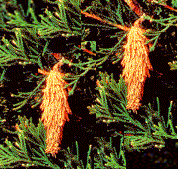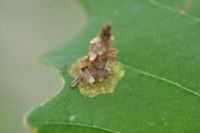By Nellie Brown

Photo from Univ. of KY
It’s not because the tree is in the holiday spirit. The “ornaments” are actually bagworms. The caterpillars eat an extremely wide range of plants (128 species), from arborvitae to maples. They can be devastating on many woody ornamentals, including many plants in your yard.

Newly hatched bagworm feeding on oak leaf surface. Larger larvae will chew holes in the leaves.
Photo from Univ. of KY
The eggs hatch in the spring and the baby caterpillars disperse over the plant where they hatched, as well as spreading out to neighboring trees, shrubs and other plants. Sometimes the newly hatched caterpillars will “balloon” to nearby plants: they will spin a long strand of silk and use that thread to catch the wind and be carried to another plant.
Each caterpillar will quickly make a bag of chewed up leaves and silk, which provides them with camouflage and protection from the elements. The bag is a home for all stages of the insects except the adult males. As the caterpillar grows, it adds to the bag and makes it larger. By June, the bagworms become noticeable to gardeners, who wonder where the “Christmas tree ornaments” came from.
In mid-summer, the larva stops feeding and forms a pupa inside the bag. At the end of summer after the adult female moth emerges from the pupa, she will wait inside the bag for the winged male bagworm moth to fly to her and mate. She will lay 300-1,000 eggs inside her bag, and those eggs will overwinter inside their mother’s bag. The next spring, the cycle begins again.
Bagworms can be devastating to woody ornamentals. Birds often do not recognize the hidden caterpillars as food, and parasitoids will not reach levels of significant control until after considerable damage has already been done to the host plant. Bacillus thuringiensis (B.t.) is very effective if applied when the caterpillars are young and small in late May and early June. Conventional insecticides labeled for leaf-feeding caterpillars will be more effective than B.t. on the older and larger bagworms, but are also most effective if used when the bagworms are young. Hand picking and destroying the bagworms is tedious but works very well, especially when done in the winter before the eggs hatch.
Nellie Brown has worked in the green industry for over fifteen years, first as a nursery inspector for the Missouri Department of Agriculture, now as an independent consultant and certified arborist. She helps people solve their insect and disease problems with their trees, garden and home. Her website is: www.nelliebrownconsulting.com.


So what do the adults look like? Are they insects?
Yes, they are insects. The adult male is a hairy moth with clear wings. The adult female looks like a soft, naked grub and remains hidden inside her bag. The adults (both male and female) are rarely seen and identified as adult bagworms. The larval bagworms are much more commonly seen by homeowners.
For more information, see the USDA website (2MB PDF).